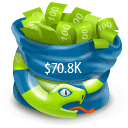 If you follow changes in SEO, you have probably recently heard the term SEO 3.0. It was coined by an SEO professional named Mike Meyer in late 2010. It is an extension of the concept of Web 2.0 but specific to search engine optimization. For anyone who is not yet familiar, here is a quick primer.
If you follow changes in SEO, you have probably recently heard the term SEO 3.0. It was coined by an SEO professional named Mike Meyer in late 2010. It is an extension of the concept of Web 2.0 but specific to search engine optimization. For anyone who is not yet familiar, here is a quick primer.Best Offers
Share with me
Thursday, March 31, 2011
SEO 3.0 – The New Rules
 If you follow changes in SEO, you have probably recently heard the term SEO 3.0. It was coined by an SEO professional named Mike Meyer in late 2010. It is an extension of the concept of Web 2.0 but specific to search engine optimization. For anyone who is not yet familiar, here is a quick primer.
If you follow changes in SEO, you have probably recently heard the term SEO 3.0. It was coined by an SEO professional named Mike Meyer in late 2010. It is an extension of the concept of Web 2.0 but specific to search engine optimization. For anyone who is not yet familiar, here is a quick primer.SEO 3.0 is an identifier meant to help organize search engine optimization phases into chunks that fit into a timeline. This ensures you are using only the most current techniques because even some from just a year or two past can get you in trouble. Following is a basic breakdown:
SEO 1.0 (1995 to 1998): This is where it all began. Basically, there were no rules. This era is affectionately known as “The Wild West of Online Marketing”.
SEO 2.0 (1999 to 2010): This is what most of us know today. Lots of rules that changed constantly.
SEO 3.0 (Oct. 2010 and on): This is what we need to know in order to succeed both today AND tomorrow. These are the new rules we need to learn and apply if we want to succeed after all the major search engine algorithm changes that happened in late 2010 and so far in 2011.
So what were the major changes? It’s more like what weren’t the major changes. There were more game changing search engine events between October 2010 and March 2011 than there had been in the previous decade combined. Let’s look at a few of the biggest:
Number One: Bing Joins Forces with Yahoo!
In late October 2010, Bing and Yahoo! made good on their long-standing threat (or promise) to unite – at least as far as rankings go. Now Yahoo!, which has about 22% of the search market volume, displays nearly identical listings to Bing. Because Bing already had about 11% of the search market’s volume, Bing and Yahoo! combined now control a full third or more of the search market.
So how does this affect you? Well, in the past many people did not bother optimizing for Bing because it accounted for so little of the actual search space. For those people, the money they spent optimizing for Yahoo! is gone with no return on investment in sight, and they have to start fresh with Bing. That is a big deal.
Tip One: Start paying more attention to getting ranked on Bing. Some of the more important things on Bing are:
Good titles that include your three most important keywords and your company name (optional) separated by pipes (Keyword 1 | Keyword 2 | Keyword 3 | Company Name).
Descriptions that contains your three most important keywords.
Making sure each keyword appears on the written page about two to three times for every one hundred words, but no more than six times on a page.
Another big deal is SEO friendly URLs. So if your keyword was “search engine friendly” this would be a great URL: domain.com/search-engine-friendly.html.
Number Two: Google Goes from Global to Local
For more than a decade Google has been proudly making the world seem smaller and smaller by being “the global search engine”. Now, it wants to be the “local search engine”. To accomplish this it has made all kinds of changes. One of the first, and biggest, was moving the Google Places ‘7-pack’ listings from the upper right corner (where most people ignored them) to be integrated right into the main search results (where nobody could miss them!) Welcome to Google’s latest and greatest “Place Search”.
What does this mean to you? It means that if you do not have a Google Places listing claimed, your nearest local competitors will be eating your lunch online when local customers find them instead of you at the top of page one search results within Google Place Search.
Tip Two: Visit “places.google.com/business” to claim your free Google Places listing. When you do, complete the listing as close to 100% as possible and then try to get some feedback posted. This will go a long way toward getting the best results from your local search engine optimization efforts.
Number Three: Google Eliminates the Need to Click
Google might have borrowed this idea from Bing (actually MSN a couple years back). It’s called Instant Preview and it makes it so potential visitors no longer have to click on your search listing to decide if they like your site. This is thanks to a small magnifying glass icon on each search result that, when clicked, turns on a preview mode that shows a large thumbnail view of your web page. If the visitor does not like the looks of it, they simply move on with having to commit to the click.
This means anyone can now really “judge your book by its cover” and never even glance at what you have to say. A few months ago all you had to worry about was compelling copywriting. Now you need to worry about getting a person to invest one second in actually clicking the link. The fewer people who visit your site, the lower your rankings will go. Yes. Google does keep an eye on site popularity.
Tip Three: If you start seeing a decline in the number of visitors to your site, try this simple test. Print out a nice color copy of your web page (usually the home page) and the closely ranked pages of your competitors. Now mount all of them on a matte board and cover it with another matte board. Then have someone unfamiliar with your site quickly glance at the (now uncovered) board with the pages on it. Reveal the pages for just 2 to 3 seconds and ask them to indicate the one they like most. Repeat this process at least five times with other volunteers. If yours is not the page the majority selects, consider revising it until it is.
These are just a few of the dozens of recent big changes in SEO. If you would like to learn how to optimize for others you can read excerpts of “SEO 3.0 – The New Rules of Search Engine Optimization” (by Mike Meyer) for free on Amazon http://www.SEO3-0.com.
Subscribe to:
Post Comments (Atom)







No comments:
Post a Comment